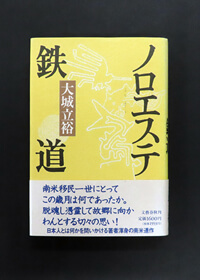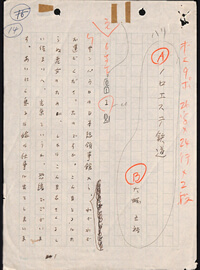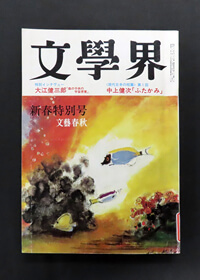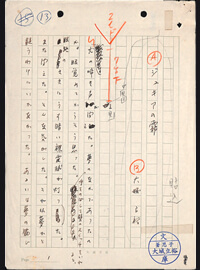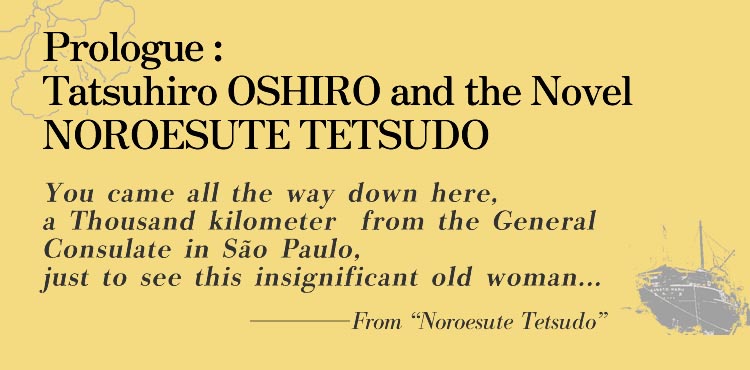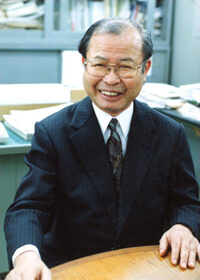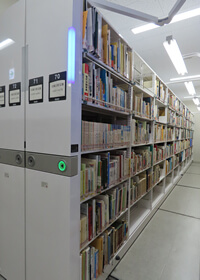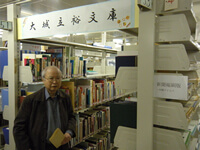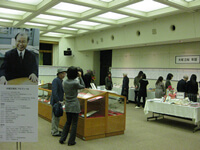01. Tatsuhiro Oshiro Collection
The Okinawa Prefectural Library, under the name Tatsuhiro OSHIRO Collection, has about 10,000 documents such as manuscripts by Tatsuhiro OSHIRO himself (Born in Nakagusuku-son municipality on September 19, 1925, dying on October 27, 2020) and other collected materials.
OSHIRO entered the Preparatory School of THE TO-A DOBUN SHOIN DAIGAKU (University of Common East Asian Culture) of Shanghai in 1943, but due to the Japanese defeat in the war the university was closed, so he was unable to complete the course. In 1947 he was admitted to the Department of Agriculture of the U.S. Military Government of the Ryukyu Islands. After serving as a Japanese language teacher at Nodake High School, he was head of the Commerce Section of the Department of Commerce and Industry of the U.S. Civil Administration of the Ryukyu Islands, Director of the Okinawa Historical Material Office of the U.S. Civil Administration of the Ryukyu Islands, continuing as an official of the Okinawa Prefecture Government after Okinawa's return to Japan and finally, director of the Okinawa Prefectural Museum, retiring in 1986.
As a writer, his work MYŌUN won the Screenwriter Award, promoted by the Culture Department of the Okinawa Civilian Administration in 1947. In 1967 he was awarded with the 57th Akutagawa Prize for "THE COCKTAIL PARTY" He continued to publish novels, dramas, critiques with the theme of Okinawan history and culture, and received awards such as the 21st Taiko Hirabayashi Literary Prize in 1993 with HI NO HATEKARA (From the end of the day), the 41st Yasunari Kawabata Literary Prize with RAIL NO MUKOU (Beyond the Rails) in 2015 and the 3rd Yasushi Inoue Cultural Award in 2019. His main works are SHOSETSU RYUKYU SHOBUN (The Solution of Ryukyu: A Novel), ASA SHANGHAI NI TACHITSUKUSU (Morning, nailed to the ground of Shanghai), FUTENMA YO (Oh Futenma) and YAKEATO NO KOKO KYOSHI (The high school teacher of the ashes), and dramas as YOGAWARI YA YOGAWARI YA (is the change of times), MADAMA MICHI RYUKYU GAKUGEKI-SHU (Madama Road: Musical Dramas of Ryukyu), HANA NO MABOROSHI - RYUKYU KUMIODORI JUBAN (Illusion of the flower - the 10 kumiodori of Ryukyu) among others.
In 2000, OSHIRO temporarily entrusted his personal collection to Okinawa Prefectural Archives, claiming the establishment of Okinawa Modern Literature Museum with his company. However, this vision did not materialize and his material was donated to this library, which carried out organizing works for its preservation and use, installing on February 17, 2010 the Tatsuhiro Oshiro Collection. The Tatsuhiro Oshiro Collection Debut Exhibition, held as an event marking the library's pre-100th anniversary, was well received by the public.
In the Collection, rare materials such as drafts of novels and plots, creation notebooks and annotations, flyers[fliers], pamphlets, posters of plays, Kumiodori and other arts, as well as magazines published in the post-war period were collected without being lost, becoming a fascinating collection. On the material of the collection, OSHIRO said "I hope that the material I leave is of some help to discover the truth of post-war Okinawa." From now on, we await researches about Tatsuhiro OSHIRO, which boosted the post-war Okinawan literature.
02. Tatsuhiro Oshiro: Investigation on Okinawans Residing in Overseas Regions
As the Director of the Historiographical Institute of Okinawa, Tatsuhiro Oshiro collected documents about emigrants visiting Okinawans residing in overseas regions twice, in 1973 and 1978. Until then, overseas investigation missions have taken place by officials from the U.S. Civil Administration of the Ryukyu Islands and was for the first time, intended for collecting documents. Okinawa Prefecture was known as one of Japan's few migratory provinces from before World War II, however, due to scarce resources, there was not much emigrant related research available.
| County | 1973 | 1978 | ||
|---|---|---|---|---|
| Bibliographic Documents | Audio | Bibliographic Documents | Audio | |
| USA (Hawaii included) | 100 | 5 | 6 | 5 |
| Argentina | 3 | 42 | 17 | |
| Brazil | 5 | 3 | 11 | |
| Bolivia | 6 | 13 | 7 | |
| Peru | 2 | 22 | 10 | |
| Total | 100 | 21 | 86 | 50 |
1973's Investigation
During approximately 4 weeks from March 30 to April 25, 1973, he visited the Okinawan communities of Brazil, Argentina, Bolivia, Peru, Los Angeles, and Hawaii, collecting more than 100 emigration related documents. Even after his return, many bibliographic documents were donated by local communities.
This year's investigation was limited in time because the governor of the Chobyo Yara, and president of the Okinawa legislative assembly, Koichi Taira, although acting separately in different regions, had conflicting schedules. Even so, OSHIRO dedicated his efforts to collecting documents by also holding fraternization events with local researchers. Those documents came to fruition in 1974 with the publication of “OKINAWA KENSHI DAI 7 KAN KAKURON HEN 6 IMIN” (Okinawa Prefecture History Vol. 7 Book 6 Migration). To this day, there are few provinces that have published an independent compilation on migration in their prefecture historical collection, suggesting the significance of emigration to this province.
1978's Investigation
Under the special order of Governor Koichi TAIRA, the second investigation was a 65-day itinerary from April 26 - June 29, 1978, through Hawaii, Samoa, Tahiti, Argentina, Brazil, Bolivia, Peru, Washington, Los Angeles and Hawaii.
This time, he made efforts to conduct interviews to preserve the audio records of the experiences of Okinawan emigrants. As for bibliographic documents, they were collected considering the assimilation with local culture, education, and cultural activities.
During this investigation, OSHIRO visited Brazil and interviewed Kame OSHIRO, an emigrant of the KASATO-MARU first trip, on May 18. He later wrote the novel, “NOROESUTE TETSUDO” (The Northwest Railroad), modeled after Kame's life story. "The story is largely aligned with her life, but as for KACHIGUMI (“the Victorious”), it's fiction", OSHIRO said.
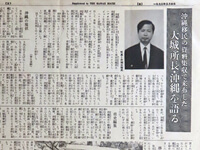
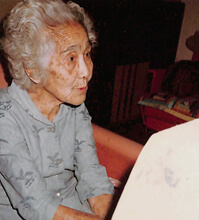
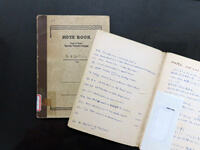
Interview with Kame Oshiro
03. About NOROESUTE TETSUDO
The novel describes the transformation of the feelings of an old lady who at the time of the celebration of 70 years of emigration to Brazil is advised to receive "the award from his Imperial Highness the Crown Prince", but only after refusing twice decided to receive in the third attempt. The story follows in narrative form, the life story of an old lady and her husband.
Born in Okinawa, the elderly lady is an emigrant of the first trip to Brazil and the plot mentions the historical aspects such as the situation of Okinawa at the time, the reasons for emigration, the boarding in the KASATO-MARU, the first farm, the work in the construction of the Estrada de Ferro Noroeste (Northwest Railway), the establishment of the residence in Campo Grande, and the chaos of the post-war at the same time incorporating several peculiar elements of Okinawa, such as political, ideological, cultural, traditional, social and natural aspects. In addition, the story has as its axis 3 dichotomous themes such as "The Avoidance of Japanese Military Service” and "The Victorious” in Brazil", "AKABANĀ (the hibiscus flower representing Okinawa) and SAKURA (the cherry tree representing Japan)" and "ISSEI (Japanese emigrant) and NISEI (son of the emigrant)".
This novel is a rare literary work that describes the arduous struggle, both psychological and material, of the Okinawan emigrants who launched themselves into the world, narrated through the life story of an Okinawan emigrant. It also provides a clue to the readers on how to understand the Uchinanchu of the world that have been connected uninterruptedly for over a hundred years.
Works published in individual books
NOROESUTE TETSUDO
(The Northwest Railway)- BUNGAKUKAI magazine
February 1985 issue
NANBEI ZAKURA
(South American Cherry Blossom)- BUNGAKUKAI magazine
February 1987 issue
The story in this issue confronts the meaning of settling in a region from the gaze of a father who went to take back his son 15 years after his emigration in 1963, after learning of the critical situation of emigrants to Bolivia.
HARUKANA CHIJO E
(The distant geoglyph)- BUNGAKUKAI magazine
August 1988 issue
A journalist receives a request from a YUTA (spiritual medium) to find NASHIKARA (in Peru), and when talking with an elder born in Okinawa and the people of the region, is then led to the immense Nazca Lines that can only be seen from the sky, trying to find a connection between Nazca and Nashikara.
JUKIA NO KIRI
(The fog of Juquiá)- BUNGAKUKAI magazine
July 1985 issue
Describes the loyalty of a man who acted as KACHIGUMI ("the Victorious”) and the ideological conflict between Okinawan emigrants and the generation that was born in Brazil.
PADORINO NI HANATABA WO
(Bouquet of Flowers to Padrino)- BUNGAKUKAI magazine
July 1989 issue
Describes the delicate situation of Okinawan emigrants and those born in Argentina who own two homelands, Japan and Argentina, since the Falklands War that took place in 1982.
Partial quote from BUNGEI TEKI SHOHYO-SHU Caption
